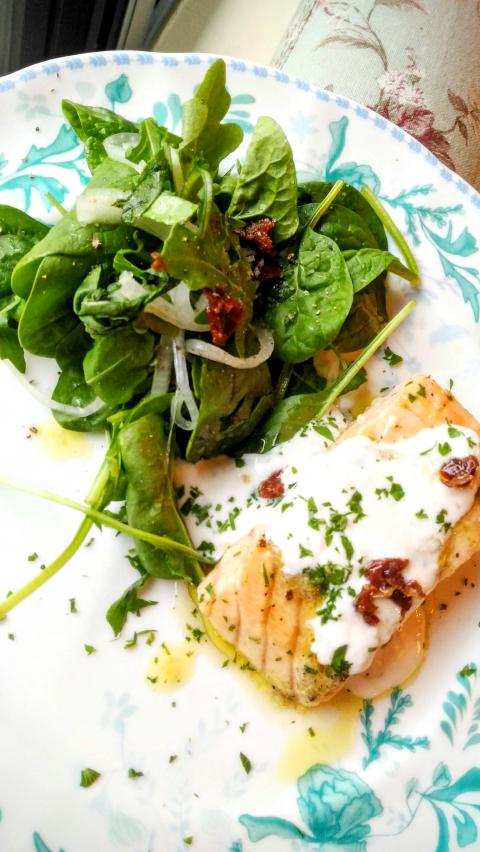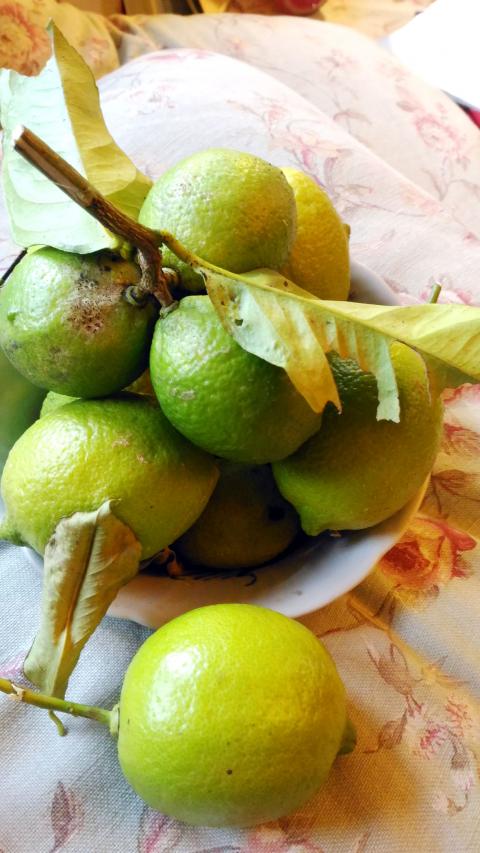In Taiwan, for the most part, lemons are green, not yellow. This causes a good deal of confusion for foreigners, for whom green is the color of limes, not lemons. This confusion is not helped by the fact that most limes are sold under the name of seedless lemons (無籽檸檬), but are in fact a seedless variety of lime. This doesn’t stop many costermongers here of lumping the two together as lemons, despite considerable differences in flavor.
KNOW YOUR LEMONS
So a basic question of identity needs to be addressed before we can go any further. The buttery bright yellow lemons that most Europeans and Americans are familiar with are almost invariably imported. These lemons, the sweetest of which are Meyer lemons, have quite distinct qualities from local lemons. If you are going to make candied lemon, Moroccan preserved lemons or any preparation in which the skin is as important as the flesh, Meyer lemons are usually the variety of choice. This is due to a sweetness that Taiwan’s green lemons do not possess, and for sweets, the peel of yellow lemons is almost invariably more attractive to look at than green, which tends toward an unattractive dark khaki when heated.

Photo: Ian Bartholomew
The lemons most readily available in Taiwan are of a type usually categorized as Eureka lemons, and due to reasons of climate and cultivation almost never become yellow. A little yellow shading amid the green when the fruit is very ripe can be found, or even occasionally a dull, bruised yellow in very old fruit, but nothing like the attractive bright coloring of imported lemons. Fortunately, for most savory preparations, this doesn’t matter too much, and there is nothing wrong with the flavor of Taiwan’s green lemons. It’s just different.
The biggest advantage of Taiwan’s green lemons is that they are available without the almost inevitable thin coating of wax that can be found on imported fruit, designed to improve its appearance on supermarket shelves. This wax isn’t going to kill you, but as someone who loves using lemon zest, I don’t feel much inclination to ingest large amounts of wax, quite apart from the issue that pesticide may often be sealed under the food wax, vastly reducing the usefulness of washing fruit as a means of removing unwanted residue.
So, looking at the Taiwan scene you have green lemons and green limes. The giveaway is that limes have a smooth skin that is much thinner than that of lemons, and tend to be rounder in shape. The lemons have a thicker skin, much courser in texture, with a slightly elongated shape. These Eureka lemons are distinct from the also widely available perfume lemons (香水檸檬), a dense, thick-skinned fruit with an intense fragrance, but which is notoriously dry. They are prized for their use in making herbal teas, and their zest can provide interesting flavor to cakes and savory dishes, but they provide very little juice. One of the most interesting preparations of these perfume lemons I have come across is to scrub their skins vigorously with salt before slicing into thin slithers and seasoning with fine Muscovado sugar and eaten as a side to strong oolong tea.

Photo: Ian Bartholomew
When I do manage to get hold of organic lemons I am loath not to make the maximum use of everything they have to offer. The zest is something I always try to incorporate in both sweet and savory dishes, and when that can’t be done, soaking the lemon peel in alcohol or vinegar for a week or two creates a brilliantly fragrant cleaner for the kitchen.
The benefits of citrus are well known, particularly as a huge storehouse of vitamins, particularly Vitamin C and also of limonoids, a substance in both lemons and limes, which are thought to be effective in retarding the occurrence of various forms of cancer. There are few of us who would eat a lemon in the way we would eat an orange, but with a little effort, lemons can be vastly more delicious than their naturally sweeter relatives. They provide a huge zing to all kinds of savory food, but even simple homemade lemonade, that doesn’t need anything more than sugar and ice, is probably the best thirst quencher and health supplement you can imagine.
Slow roasted salmon with lemon yogurt
Recipe
(serves two)
Slow roasting fish at low temperature is one of the most forgiving methods available for thick fillets, perfect for salmon, but also for rich white fish like mahimahi (see Taipei Times April 16, 2016). This method of cooking helps retain moisture and minimizes the risk of over cooking. This dish uses Eureka lemons, which are easily available in Taiwan throughout the year, as well as preserved Meyer lemons, a Moroccan specialty that I make a point of having in my larder at all times. Preserved lemons are available at some specialty food establishments and can also be made at home, and are a perfect addition to everything from sauces to fried meat (see the recipe for crispy-skinned lemon chicken with sauteed mustard greens, Taipei Times Oct. 31, 2015).
Ingredients
2 skinless salmon fillets (approx. 150g each)
1 lemon (preferably organic and unwaxed)
1/4 cup olive oil
1/2 cup thick yogurt, preferably homemade
1/4 preserved lemon (optional, or chopped capers are a decent substitute),
1 clove garlic
Small bunch baby spinach
Small bunch baby arugula
Half a small onion
1 sun dried tomato, minced (optional)
Salt and black pepper
Splash of aged balsamic vinegar
Flat leaf parsley, finely chopped
Directions
1. Clean the salmon fillets and place them in a heatproof dish. Zest the lemon over the fish and squeeze the lemon, pouring the juice over the fillets.
2. Season generously with salt and pepper then add a good glug of olive oil. Coat the fish thoroughly with the mixture and set aside for about 10 minutes.
3. Preheat oven to 100 degrees Celsius.
4. Meanwhile, remove the flesh from the preserved lemon and mince the skin. Mince the garlic. Add both to the yogurt and season generously with salt and pepper.
5. Place the fish on the bottom shelf of the oven and roast for 25 to 30 minutes, until the internal temperature reaches 50 degrees Celsius. If something comes up, you can turn off the heat and keep the fish warm in the oven for 10 minutes, or 20 at a push, with nothing too terrible happening (though with some loss to the melting softness of the barely cooked meat, which is one of my favorite things about this dish).
6. Toss the baby spinach, arugula, sun dried tomato with salt, pepper, vinegar and olive oil.
7. Plate the fish together with the salad, and pour any pan juices over the fish.
8. Top the fish with a dollop of yogurt and sprinkle with flat leaf parsley.
9. Serve with crusty bread and lots of butter. Paired with a glass of antipodean pinot noir or a lush white burgundy and you are rocking.
Ian Bartholomew runs Ian’s Table, a small guesthouse in Hualien. He has lived in Taiwan for many years writing about the food scene and has decided that until you look at farming, you know nothing about the food you eat. He can be contacted at Hualien202@gmail.com.

Following the shock complete failure of all the recall votes against Chinese Nationalist Party (KMT) lawmakers on July 26, pan-blue supporters and the Chinese Communist Party (CCP) were giddy with victory. A notable exception was KMT Chairman Eric Chu (朱立倫), who knew better. At a press conference on July 29, he bowed deeply in gratitude to the voters and said the recalls were “not about which party won or lost, but were a great victory for the Taiwanese voters.” The entire recall process was a disaster for both the KMT and the Democratic Progressive Party (DPP). The only bright spot for

Water management is one of the most powerful forces shaping modern Taiwan’s landscapes and politics. Many of Taiwan’s township and county boundaries are defined by watersheds. The current course of the mighty Jhuoshuei River (濁水溪) was largely established by Japanese embankment building during the 1918-1923 period. Taoyuan is dotted with ponds constructed by settlers from China during the Qing period. Countless local civic actions have been driven by opposition to water projects. Last week something like 2,600mm of rain fell on southern Taiwan in seven days, peaking at over 2,800mm in Duona (多納) in Kaohsiung’s Maolin District (茂林), according to

Aug. 11 to Aug. 17 Those who never heard of architect Hsiu Tse-lan (修澤蘭) must have seen her work — on the reverse of the NT$100 bill is the Yangmingshan Zhongshan Hall (陽明山中山樓). Then-president Chiang Kai-shek (蔣介石) reportedly hand-picked her for the job and gave her just 13 months to complete it in time for the centennial of Republic of China founder Sun Yat-sen’s birth on Nov. 12, 1966. Another landmark project is Garden City (花園新城) in New Taipei City’s Sindian District (新店) — Taiwan’s first mountainside planned community, which Hsiu initiated in 1968. She was involved in every stage, from selecting

As last month dawned, the Democratic Progressive Party (DPP) was in a good position. The recall campaigns had strong momentum, polling showed many Chinese Nationalist Party (KMT) lawmakers at risk of recall and even the KMT was bracing for losing seats while facing a tsunami of voter fraud investigations. Polling pointed to some of the recalls being a lock for victory. Though in most districts the majority was against recalling their lawmaker, among voters “definitely” planning to vote, there were double-digit margins in favor of recall in at least five districts, with three districts near or above 20 percent in